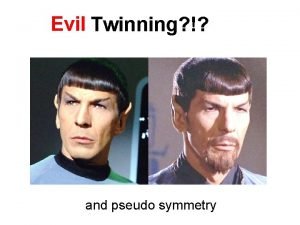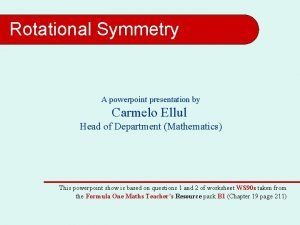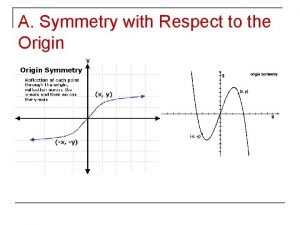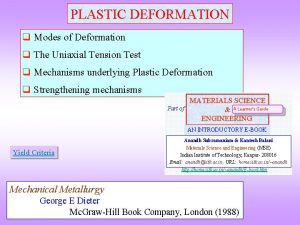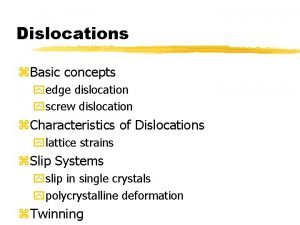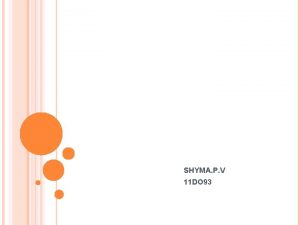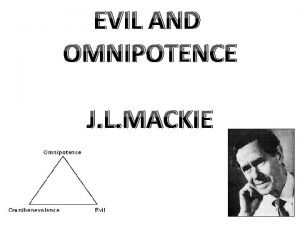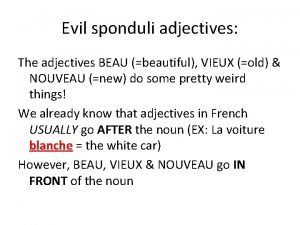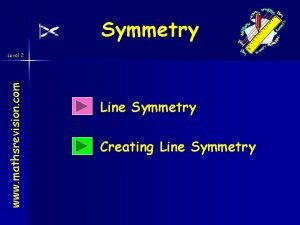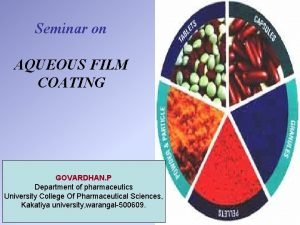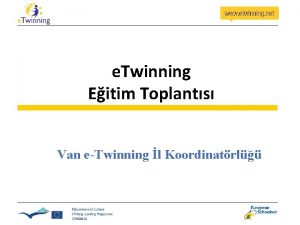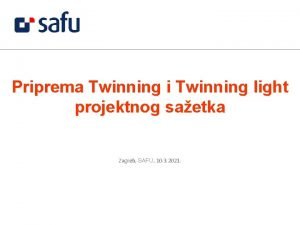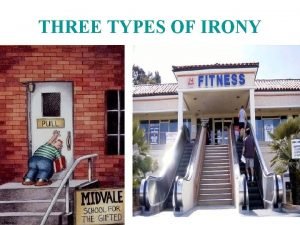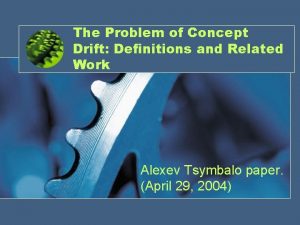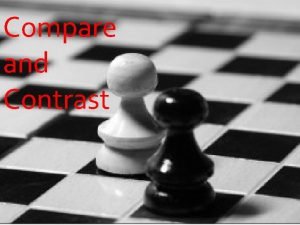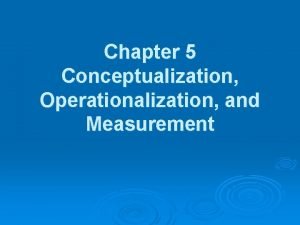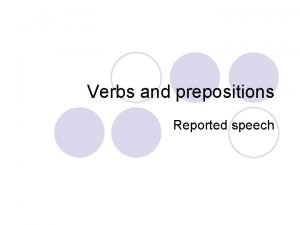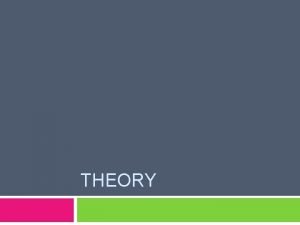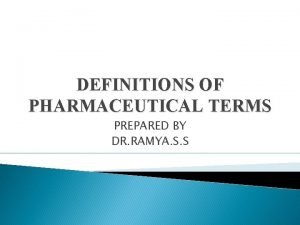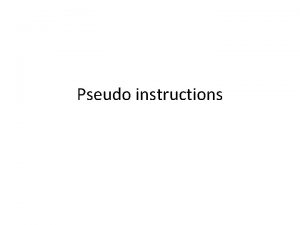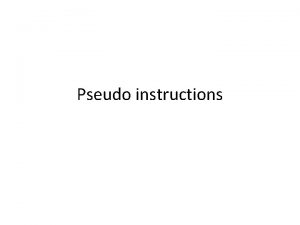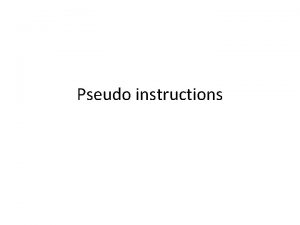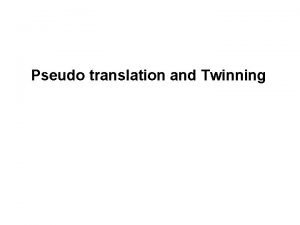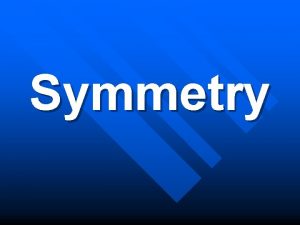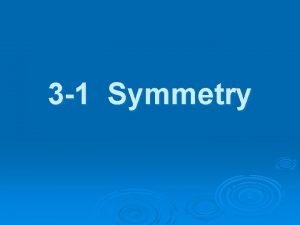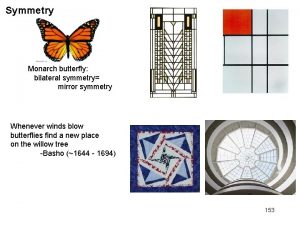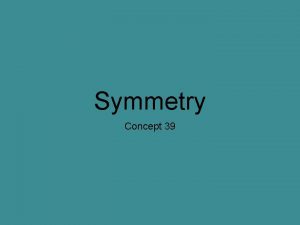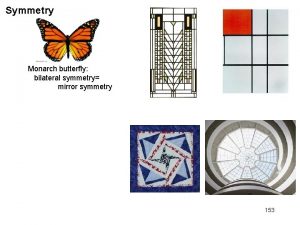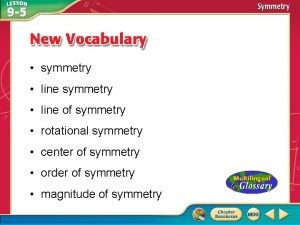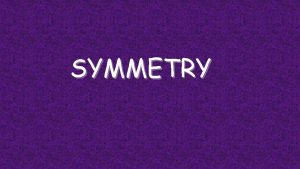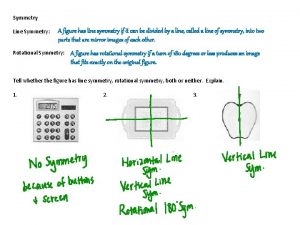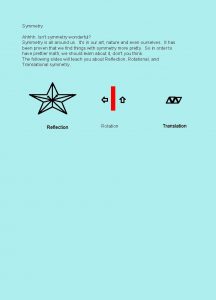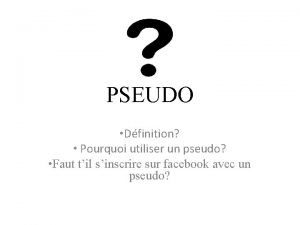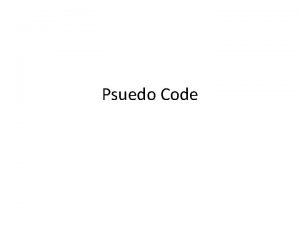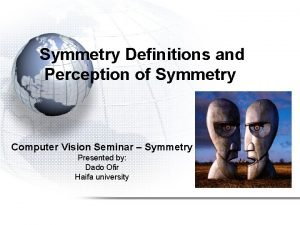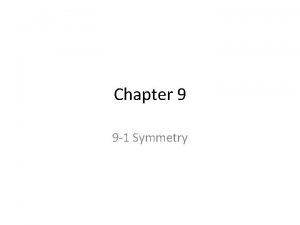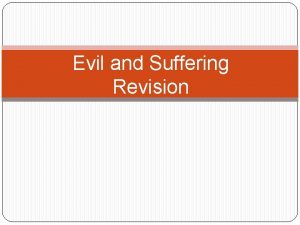Evil Twinning and pseudo symmetry Definitions Twinning Two




















































- Slides: 52

Evil Twinning? !? and pseudo symmetry

Definitions: • Twinning: – Two (or more) crystals of the same species joined together with different orientations • Twin law: – Symmetry operator that rotates one crystal lattice onto the other (common: k, h, -l) • Twin fraction ( α ): – Mixing ratio: Iobshkl = α Ihkl + (1 -α) Ikh-l Thanks to: Andrea Thorn

Types of twinning 1. Merohedral Twin law is symmetry operator for lattice, but not the true point group 2. Pseudo-merohedral Twin law not symmetry operator for lattice 3. Non-merohedral Lattices don’t perfectly overlap 4. Epitaxial Crystals randomly stuck together Thanks to: Andrea Thorn

Can you tell by looking? Macroscopic twin Disecting apart might give a single crystal! Microscopic twin Crystal looks fine, but is twinned. Images property of Andrea Thorn and Claudia Egerer-Sieber

Merohedral twinning : wal niw. T t fo rotarepo yrtemmy. S s‘latsyrc eht ton tub Reciprocal lattice rehgih skool yrtemmys )1 i noitubirtsid ytisnetn. I )2 Thanks to: Andrea Thorn

Twinning: how can you tell?

Counts/bin Make a histogram of your data Spot intensity

Counts/bin Make a histogram of your data Spot intensity

Pseudotranslation → alternating spots https: //dials. github. io/documentation/tutorials/centring_vs_pseudocentring. html

Aside: Pseudo-translation NCS kills Phaser

The “H test” for twinning Two intensities I 1 and I 2 are related by twin law: (For acentric reflections: ) Cumulative propability distribution Drawback: Perfect twins are not detectable Thanks to: Andrea Thorn

Cumulative distribution of H 1. 0 N (H) 0. 8 0. 5 α=0. 4 α=0. 3 α=0. 2 α=0. 1 α= 0 0. 4 0. 2 0 0. 1 0. 2 H 0. 3 0. 4 0. 5 Thanks to: Andrea Thorn

Yeates-Padilla “L-Test“ The reflections with the intensities IA and IB are close to each other in reciprocal space: If α=0. 5: Thanks to: Andrea Thorn

Yeates-Padilla “L-Test“ acentric reflections, perfect twin acentric reflections, untwinned Centric, untwinned Available using POINTLESS CTRUNCATE or DETWIN in CCP 4 N (|L|) This test shows the 1. 0 expected cumulative distributions for perfect twins and untwinned data. 0. 8 Partial twins will be between the curves. 0. 6 0. 4 0. 2 0 0 0. 2 0. 4 0. 6 |L| 0. 8 1. 0

Apparent “twinning” of XFEL data Beam center from autoindexing Sauter (2015). JSR 22, 239.







Twinning: how can you tell? 1. Intensity distribution is abnormal H test, L test 2. Rmerge for higher symmetry < 50% → might be twin < 10% → could be 50: 50 twin 3. one of the “usual suspects” P 622, P 6, P 321, P 312, P 422, P 43 http: //www. ccp 4. ac. uk/html/twinning. html 4. can’t solve it

Find the twin law? 1. refine in REFMAC Automatically checks all possible twin laws! 2. copy twin law into other programs: phenix. refine, etc. Pick Rfree flags in highest symmetry i. e. P 622 if true SG is P 3 Do not “twin refine” if not twinned control: swap non-twin operator

Reticular merohedry Most common case: Obverse/reverse twinning in R 3 x Crystal lattice Reciprocal lattice R 3 looks like P 31 R 32 looks like P 3121 1/3 reflections missing, but not conventional systematic absences Thanks to: Andrea Thorn

Pseudo-merohedral twinning Twin law belongs to higher crystal system than true SG Crystal lattice Reciprocal lattice Can happen if true unit cell can be transformed into higher-symmetry crystal system. Thanks to: Andrea Thorn

Other pseudo-merohedral twin examples True Pseudo Geometric Twin SG SG notes operator P 21 P 2221 C 2221 Β=90° a=c h, -k, -l l, -k, h Example structures 1. 2. 3. Cocaine hydrolytic Fab (Larsen 2002) α-amino-acid ester hydrolase (Barends 2003) PLP-dependent catalytic Fab (Golinelli. Pimpaneau, 2005) 1. 2. 3. Deoxyhaemoglobin (Ito 1995) 50 S ribosome subunit (Ban 1999) Gd. P capsid-stabilizing protein phage λ (Yang et al. 2000) Ortithine 5’ mono. PO 4 decarboxylase (Wittmann 2007) Aclacinomycin oxidoreductase (Sultana 2007) Dihaem c-type cytochrome DHC 2 (Heitmann 2008) 4. 5. 6. P 21 C 2221 c*cos(β) = -a/2 C 2 F 222 C*cos(β) = -a/2 -h, -k, h+l h, -k, -h-l 1. 2. 3. Peroxiredoxin 5 (Declercq 2001) Poly Ig-binding frag (Hamburger 2004) ϒδ T-cell ligand T 10 (Rudolph 2004) -h, -k, h+l 1. 2. Acetyl-Co. A synthase (Lehtio 2005) THATCH domain HIP 1 R(Brett 2006)

Twinning: what do I do? 1. Integrate with low-symmetry SG Yes, all possible ones 2. try to solve it Yes, in all possible SGs MR: good chance if copies = 1 MAD: maybe S-SAD: no way MIR: if you’re lucky Thanks to: Andrea Thorn

Choanoflagelate Ras – 5 WDR Estimated twin fraction alpha from cumulative N(|L|) plot : 0. 129 (+/-0. 013) < |L| >: 0. 432 (0. 5 untwinned, 0. 375 perfect twin) Estimated twin fraction alpha from < |L| > : 0. 122 < L^2 >: 0. 258 (0. 333 untwinned, 0. 2 perfect twin) Estimated twin fraction alpha from < L^2 > : 0. 113 analysis by Christine Gee

Zanuda run Step 2. Refinements in subgroups. There are 5 subgroups to tes | >> 1 | P 1 | 0. 0000 | -| 0. 3126 | 0. 3207 | 1 | P 1 | 0. 1152 | 0. 2852 | 0. 2991 | 0. 3314 | 2 | P 1 21 1 | 0. 1152 | 0. 2871 | 0. 2960 | 0. 3265 | 3 | C 1 2 1 | 1. 4200 | 0. 3925 | 0. 3702 | 0. 4100 | 4 | C 1 2 1 | 1. 3816 | 0. 3896 | 0. 3688 | 0. 4202 | 5 | C 2 2 21 | 1. 4337 | 0. 4045 | 0. 3727 | 0. 4141 | << 2 | P 1 21 1 | 0. 1152 | 0. 2871 | 0. 2960 | 0. 3265 Step 3. Refinement of the best model. Candidate symmetry elements are added one by one. | >> 2 | P 1 21 1 | 0. 1152 | 0. 2871 | 0. 2960 | 0. 3265 | 1 | P 1 | 0. 1240 | 0. 2849 | 0. 2990 | 0. 3324 | 2 | P 1 21 1 | 0. 1341 | -| 0. 2939 | 0. 3290 | 5 | C 2 2 21 | 1. 3778 | -| 0. 3694 | 0. 4248 | << 2 | P 1 21 1 | 0. 1341 | -| 0. 2939 | 0. 3290 R-factor in the original subgroup is NOT the best. The original spacegroup assignment seems to be incorrect. Final twin fraction: 0. 47 operator: l, −k, h analysis by Christine Gee

Twinning Or Static Disorder? 5 Ig 5 Cam. Kii analysis by Christine Gee

Data scaled & solved as P 3121 Cell: 113. 97 241. 64 90 90 120 Reso Compl I/Sig R-meas CC 1/2 CCano 8. 82 98. 6 28. 52 3. 9% 99. 8* 19* 6. 29 99. 4 19. 04 5. 8% 99. 7* 5 5. 15 99. 6 13. 16 9. 1% 99. 2* 6 4. 46 99. 4 14. 80 8. 1% 99. 3* 7 4. 00 99. 6 10. 67 11. 8% 99. 0* 4 3. 65 99. 8 6. 38 23. 1% 95. 1* 4 3. 38 99. 7 3. 63 42. 1% 87. 7* 5 3. 16 99. 7 1. 90 83. 8% 63. 2* 2 2. 98 89. 3 1. 06 144. 0% 34. 5* 1 total 97. 9 8. 26 14. 4% 99. 4* 4 analysis by Christine Gee

P 3121 P 31 < |L| >: 0. 473 < L^2 >: 0. 303 Estimated twin fraction < |L| >: 0. 494 < L^2 >: 0. 325 Estimated twin fraction from cumulative N(|L|) plot: 0. 040 (+/-0. 005) 0. 007 (+/-0. 001) from < |L| > 0. 035 from < |L| > 0. 007 from < L^2 > 0. 032 from < L^2 > 0. 007 The L-test suggests that the data are not twinned analysis by Christine Gee

P 31 phenix. xtriage Analysis of twin law h, -h-k, -l The largest off-origin peak in the Patterson function is 3. 15% of the height of the origin peak. No significant pseudotranslation is detected. Estimation of twin fraction: via mean |H|: 0. 433 The results of the L-test indicate that the intensity statistics behave as expected. No twinning is suspected. via cum. dist. of H: The symmetry of the lattice and intensity however suggests that the input space group is too low. Britton analyses Estimated twin fraction: 0. 439 0. 419 analysis by Christine Gee

P 3121 and static disorder analysis by Christine Gee

P 31 and twinned analysis by Christine Gee

Non-merohedral twinning Diffraction image Images courtesy of Madhumati Sevvana

Non-merohedral twinning • For indexing, leave out partial overlaps at first. • Find a cell that fits a reasonable fraction of spots. • Use the not-yet-indexed reflections to find an alternative orientation of the same cell; repeat as necessary. (FECKLESS will search for any new cell. ) • Something like this can be done with – XDS (use omitted reflections) – MOSFLM & FECKLESS (multi keyword in auto-indexing) – CELL_NOW (proprietary) – DIALS Thanks to: Andrea Thorn

Twinning Summary “Twins cannot be detected without prior suspicion. “ -Andrea Thorn Many tests, but all can be fooled Try all possible space groups: Zanuda Pick Rfree flags using highest possible symmetry Solve a twinned structure → job prospects good

Further reading • Bernhard Rupp, Biomolecular Crystallography: Principles, Practice, and Application to Structural Biology, 2004 • Yeates Server: http: //nihserver. mbi. ucla. edu/Twinning • Simon Parsons, Introduction to twinning, Acta Cryst. (2003). D 59, 1995 -2003 • Zbigniew Dauter, Twinned crystals and anomalous phasing, Acta Cryst. (2003). D 59, 2004 -2016 Thanks to: Andrea Thorn

Pseudotranslation → alternating spots

Trick Question: What is the space group? a = 63 b = 63 c = 63 α = 90 β = 90 γ = 90

There are 16 different “beam centers” Beam Y Origin Beam X

There are 16 different “beam centers” Beam Y Origin Beam X

There are 16 different “beam centers” Beam X Origin Beam Y

There are 16 different “beam centers” Origin Beam X Beam Y

There are 16 different “beam centers” Beam Y Origin Beam X

There are 16 different “beam centers” Beam X Origin Beam Y

There are 16 different “beam centers” Origin Beam X Beam Y

There are 16 different “beam centers” Beam Y Origin Beam X

There are 16 different “beam centers” Origin Beam Y Cameraman View Beam X Beam View

There are 16 different “beam centers” Origin? Origin?

There are 16 different “beam centers” 1. Xbeam, Ybeam 2. Ybeam, Xwidth – Xbeam 3. Xwidth-Xbeam, Ywidth-Ybeam 4. Ybeam, Xbeam 5. Xbeam, Ywidth-Ybeam 6. Xbeam, Ybeam-Ywidth 7. Xbeam, -Ybeam 8. Xwidth-Xbeam, Ybeam 9. Xwidth-Xbeam, Ywidth-Ybeam 10. Xwidth-Xbeam, Ybeam-Ywidth 11. Xwidth-Xbeam, -Ybeam 12. Xbeam, Ybeam 13. Xbeam, Ywidth-Ybeam 14. Xbeam, Ybeam-Ywidth 15. Xbeam, -Ybeam Xwidth, Ywidth = size of detector Can be in pixels or mm Can also be: 17. “wrong”
 Truesgis
Truesgis Romans 12:17-21
Romans 12:17-21 Curve sighet
Curve sighet Symmetry elements and symmetry operations ppt
Symmetry elements and symmetry operations ppt Graph symmetric to origin
Graph symmetric to origin Good and evil in romeo and juliet
Good and evil in romeo and juliet Difference between slip and twinning
Difference between slip and twinning Screw dislocation animation
Screw dislocation animation Do93
Do93 List of degree of comparison
List of degree of comparison Evil and omnipotence mackie
Evil and omnipotence mackie Greater than god and more evil
Greater than god and more evil Vieux feminin
Vieux feminin Guttering definition ww1
Guttering definition ww1 The coexistence of good and evil
The coexistence of good and evil Finally brethren be strong in the lord
Finally brethren be strong in the lord Shakmet
Shakmet Hatred jealousy and envy
Hatred jealousy and envy What is two lines of symmetry
What is two lines of symmetry What prism has 6 planes of symmetry
What prism has 6 planes of symmetry Twinspace etwinning net
Twinspace etwinning net Twinspace nedir
Twinspace nedir Twinning tablet defects
Twinning tablet defects Live etwinning.net
Live etwinning.net Twinningtwinspace
Twinningtwinspace Etwinning portal
Etwinning portal Etwinning l
Etwinning l Etwinning.net
Etwinning.net Etwinningonline
Etwinningonline I twinning
I twinning Fridge twinning
Fridge twinning E twinning
E twinning 3 types of irony
3 types of irony The problem of concept drift: definitions and related work
The problem of concept drift: definitions and related work Safety terms and definitions
Safety terms and definitions Framing terms and definitions
Framing terms and definitions Material properties and definitions
Material properties and definitions What does incessant mean in hatchet
What does incessant mean in hatchet Timeliness news stories
Timeliness news stories Compare and contrast definitions
Compare and contrast definitions Cscmp definition of supply chain management
Cscmp definition of supply chain management Define undefined terms
Define undefined terms What is the classification of kubing
What is the classification of kubing Film genres and definitions
Film genres and definitions Operationalization and conceptualization
Operationalization and conceptualization Biconditional
Biconditional Compound weld symbols
Compound weld symbols Match the verbs with the prepositions
Match the verbs with the prepositions A set of interrelated concepts definitions and propositions
A set of interrelated concepts definitions and propositions Restaurant terms and definitions
Restaurant terms and definitions Undefined terms and basic definitions worksheet answers
Undefined terms and basic definitions worksheet answers Pharmacopedics
Pharmacopedics Monomer liquid and polymer powder
Monomer liquid and polymer powder
